Introduction
- Nurses encounter diversity on the daily basis.
- It requires individual approach.
- There are still clashes between the approach of the western medicine and cultural and religious beliefs of some communities and populations.
- Key: creative problem-solving.
- The Pashtun culture is one of the groups that present a challenge for the nurses and requires individual approach.
Throughout their practice, nurses tend to encounter very diverse individuals and groups of the population.
Individual approach is the only way that helps nurses achieve successful and effective communication with the diverse patients. However, sometimes, nurses face challenges when working with the individuals and communities whose cultural and religious beliefs clash with those of the Western health care. In such situations, nurses are required to use creative problem-solving and decision-making. This presentation will overview one of such groups – the Pashtun culture and the challenges a nurse may face working with its representatives.
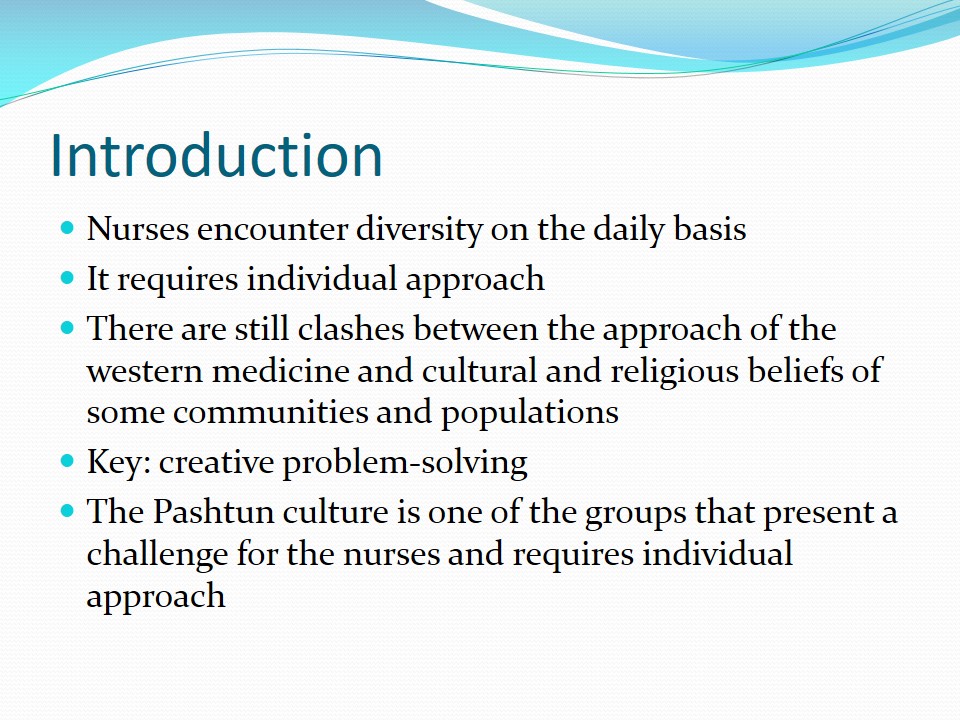
Overview of the Pashtun Culture
- Originates in Afghanistan.
- Major ethnic group in the country.
- About 52% of the population.
- At least 50 million people.
- Majority are Sunni Muslims.
- Shi’a Muslims – small minority.
- Have lived on the territory of Afghanistan for hundreds of years (Merrill, Paxson, & Tobey, 2006).
The Pashtun culture originates in Afghanistan and is the largest ethnic groups of the Afghan population that represents about 52% of it and includes around 50 million people. The majority of the group are Sunni Muslims; also, a small group adheres to the beliefs and values of Shi’a. Overall, this ethnic group has been dwelling on the territory of the modern Afghanistan for hundreds of years.
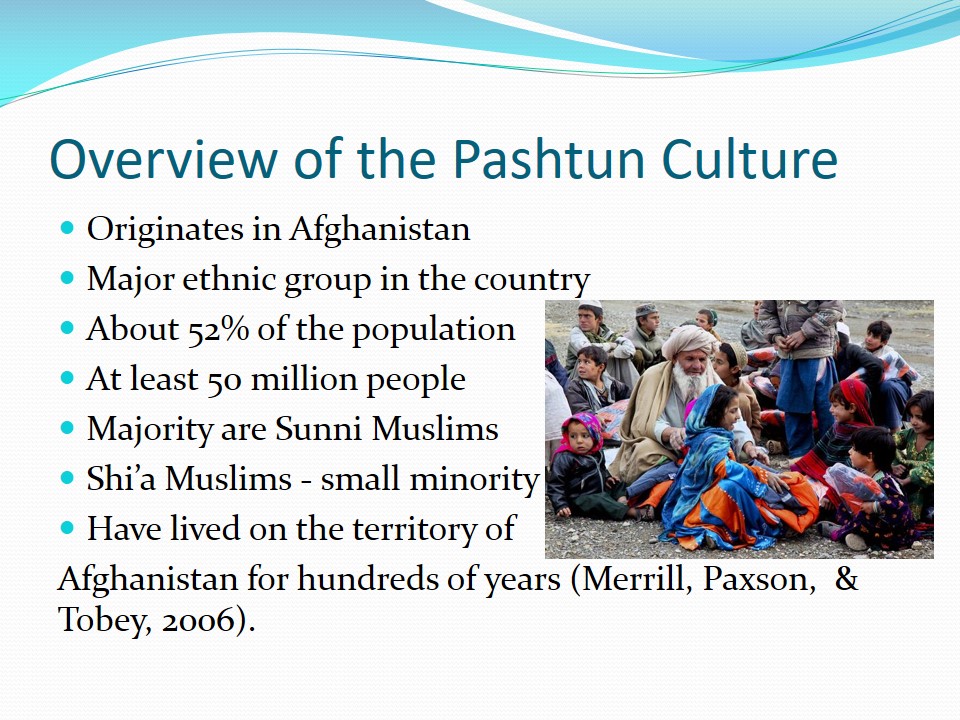
Unique Care Concerns
Environmental factors typical for the areas where the Pashtuns live:
- Poor access to health care services due to geographical location).
- Insufficiency of resources due to the weak state budget and economical situation.
- Poor living conditions – lack of good nutrition and adequate sanitation (The Pashtun Times, 2016).
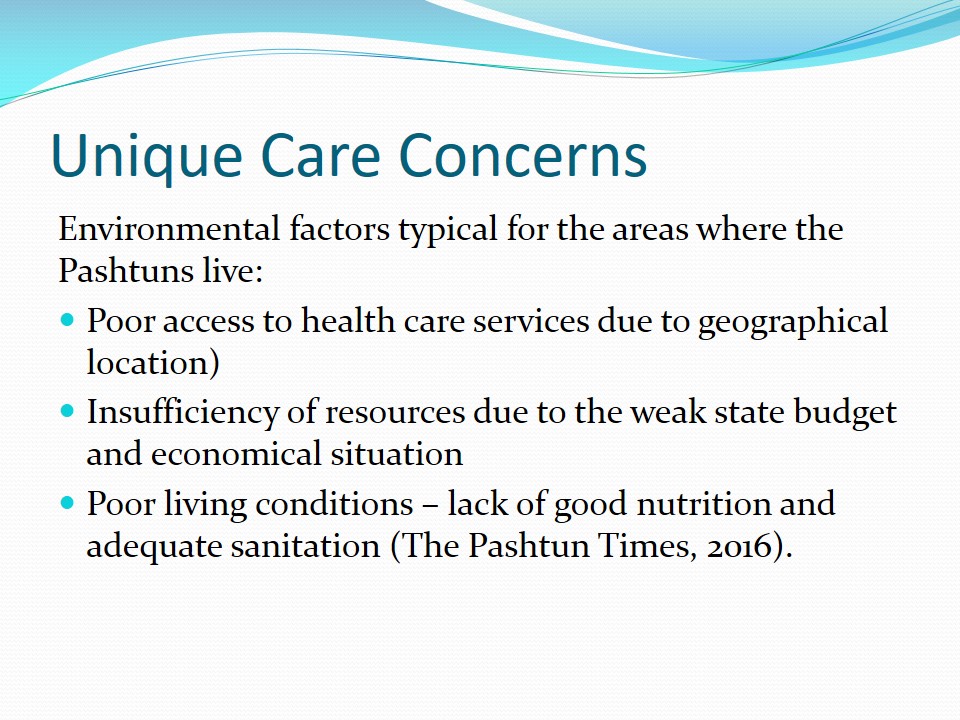
Family Structure
- Big joint families.
- High level of solidarity and unity.
- Collective culture.
- Living in one big group.
- The father is the main authority.
- The mother has her own sphere of influence (household mainly).
- Respect for elders.
Joint families of Pashtuns live in large houses. All the family members including the sons who already have families of their own dwell under one roof and under one authority of the father. The elders help make important decisions as the wisest community members.
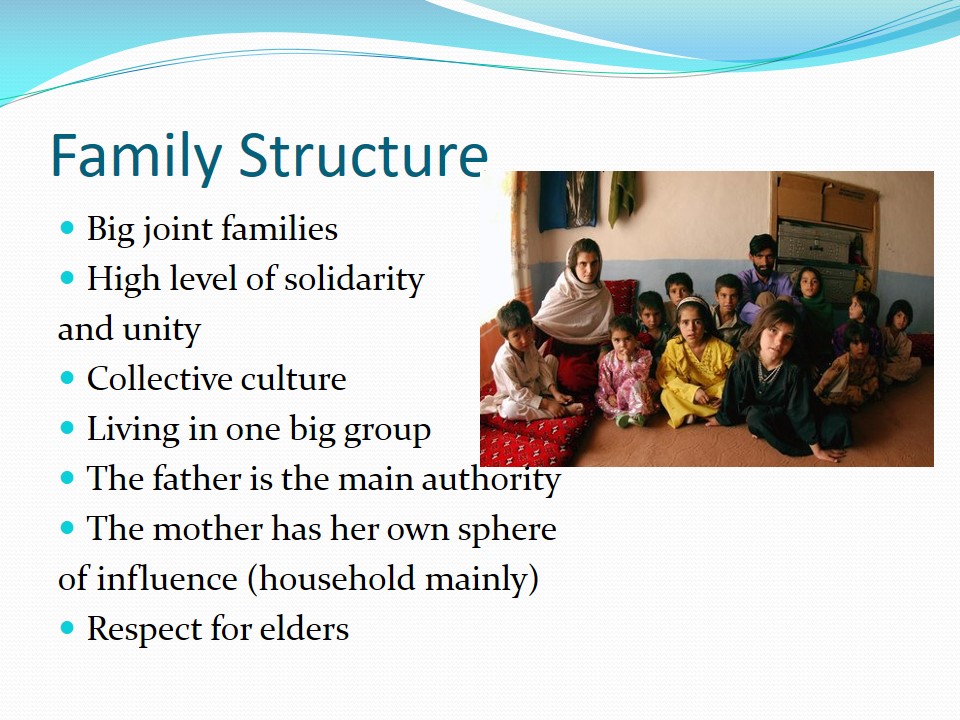
Values
- As a culture, the Pashtuns value independence.
- Proud to be a separate community.
- Complex family tree and authority systems.
- Responsibilities and rights correspond to one’s position in the family tree.
- Respect for parents and elders.
- Manners play an important role (greetings and salutations).
- People of opposite sexes who are not related do not communicate with one another (Pashtun Culture and History, 2011).
The relationships between men and women in the Pashtun culture are very complicated. Men and women who do not belong to one family do not interact. A woman does not talk to a male stranger unless she is in a desperate need of his help. A man’s attempt to speak to an unrelated woman will cause anger of her family.
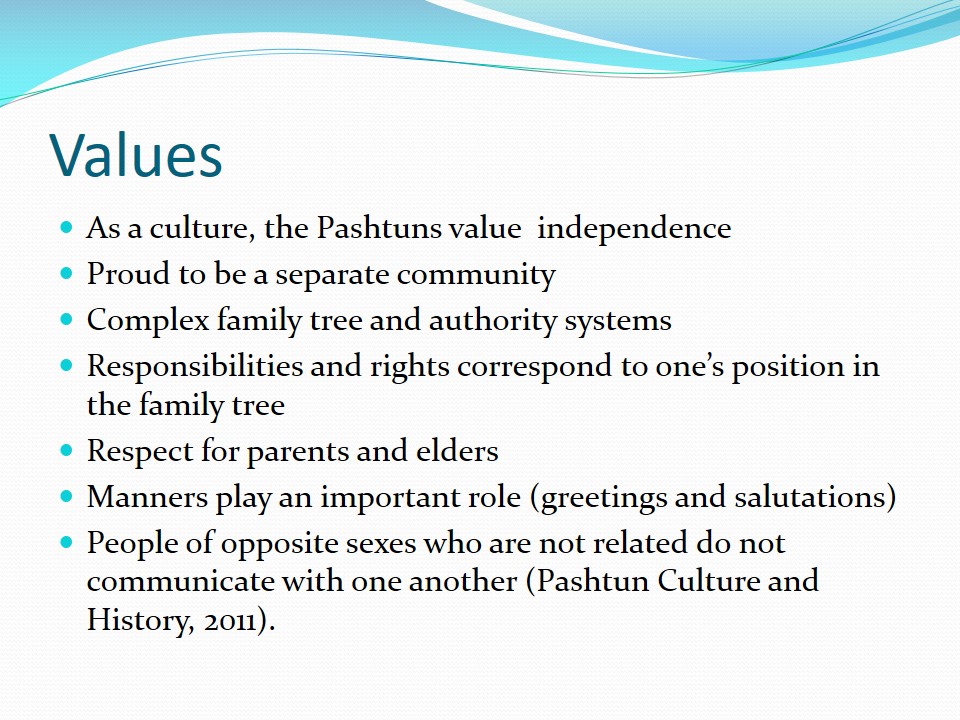
Religious and Spiritual Beliefs
- Most Pashtuns are Sunni Muslims with very strict rules.
- Women wear burqas.
- Women cannot be touched.
- Distinct gender roles, patriarchal families and society.
- Significant role of grandparents.
Women wear burqas that cover their bodies from head to toe. It is not allowed for women older than ten years of age to be touched by strangers (especially by those of the opposite sex)
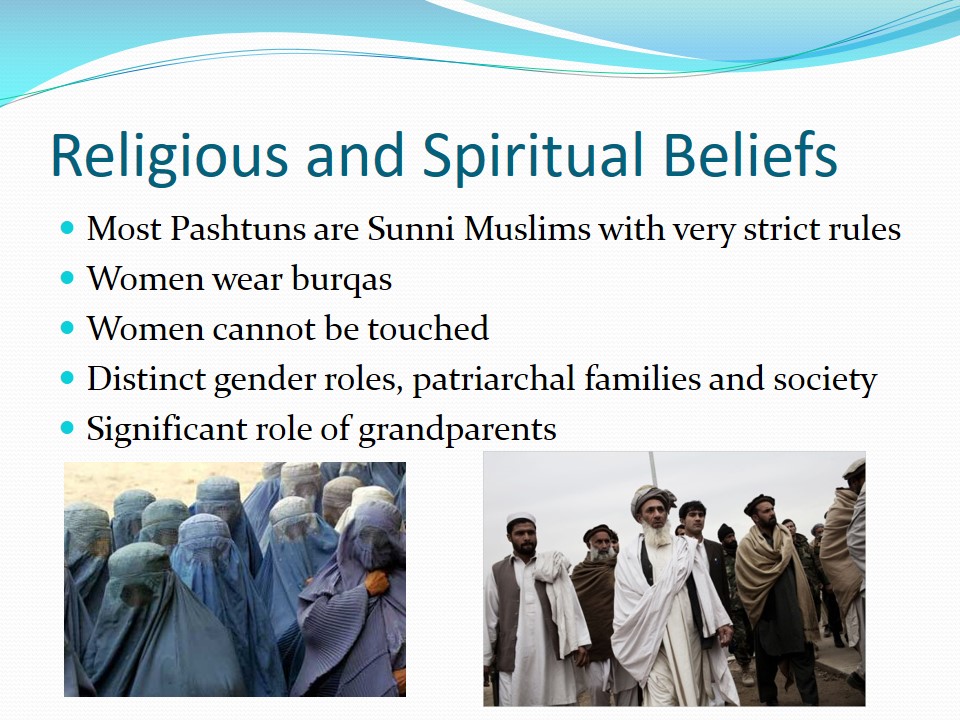
The Effect of Beliefs on Health Care
When receiving health care services or undergoing procedures:
- The males or elders of a family may ask the physicians not to tell the females their diagnosis.
- The elders or parents may request to be present at an invasive procedure and supervise.
- The assessment may be ethically problematic if a healthcare worker and the patients are of different sexes.
- End of life decision of the elderly are heavily impacted by religious and spiritual beliefs (Lamar Soutter Library, 2016).
- DNR status may be viewed as suicide.
- Alternative medicine.
DNI or DNR status of a patient is not something the Pashtuns would agree to because it may be seen as suicide that is forbidden in their religion. Moreover, many Pashtun tribes may refer to the help of the local healers who practice alternative medicine that is based on the understanding of disease as the result of imbalance in a human body that is normally based on the harmonious influence of four elements (fire, water, earth, and air), four humors (yellow bile, black bile, phlegm, and blood), and four natures (wet, dry, hot, and cold) (Lamar Soutter Library, 2016). In that way, in this system of beliefs, the diseases are addressed and eliminated by means of restoring the balance in all these factors.

Language and Communication
- Pashto language.
- Pashtunwali (the traditional code of manners and conduct).
- Strict hierarchy in the society and family.
- System of greetings (between people of the same sex; unrelated people of opposite sexes do not touch or talk).
- System of titles included in the names.
- Small intimate space (people stand close to one another while speaking).
- Asking personal questions to get to know their healthcare worker.
- It will take several visits to establish a trusting relation with a Pashtun family (Lamar Soutter Library, 2016).
In terms of communication and interaction, the Pashtun culture is characterized by two distinct features – their language (Pashto) and their manners that come from Pashtunwali – the code of behavior (Pashtun People, 2015).
The Pashtuns use titles that reflect the people’s positons in the society (tribe identity, social class, occupation).
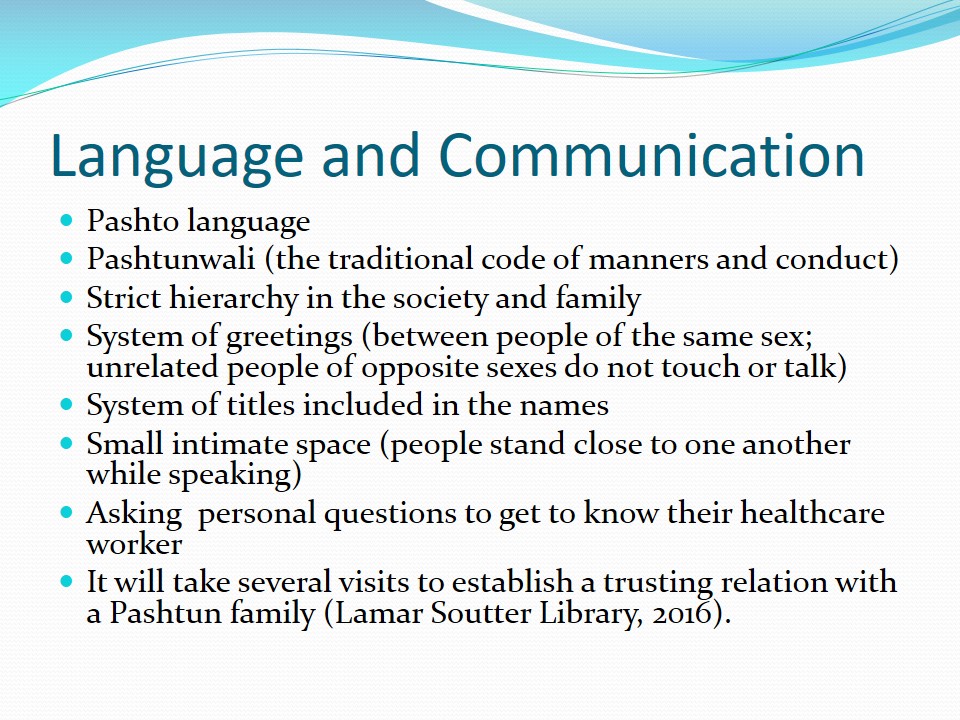
The Nurses’ Role
Working with a Pashtun patient a nurse should:
- Remember that the family will want to participate.
- Be open and honestly answer the questions from the family members for better trust.
- Consider the family hierarchy and the decision-makers of the family.
- Communicate respectfully using greetings, titles.
- Discuss how the assessment will go if the nurse and the patient are of different sexes.
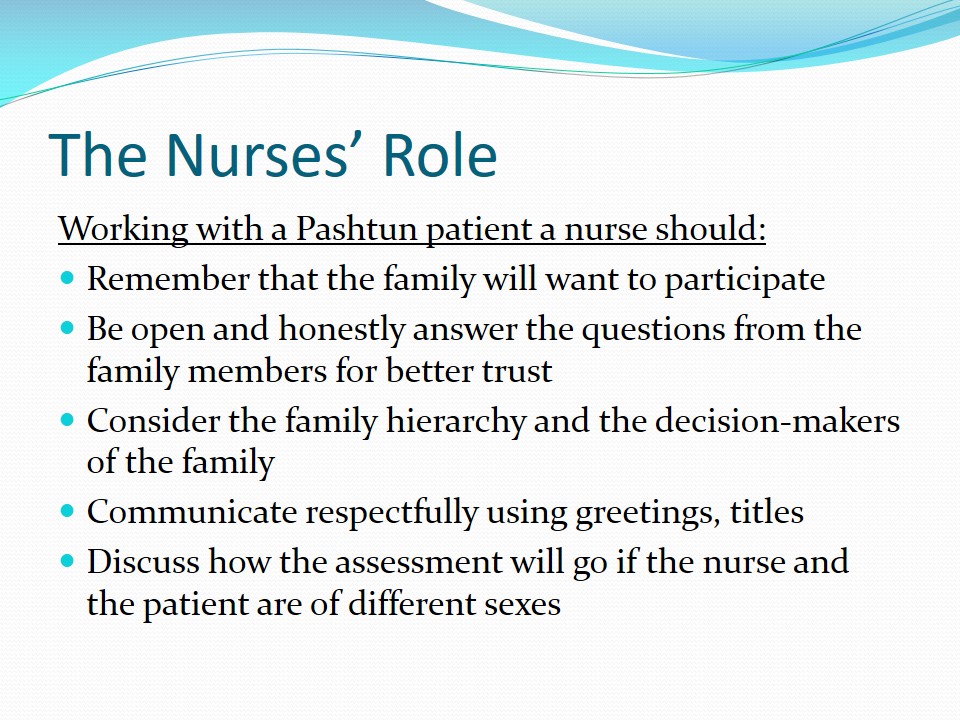
Achieving Effective Communication
- Thorough preparation before interaction with the Pashtun patient and family.
- Respect to the traditions and beliefs.
- Respect of authorities (patient is not always the key decision-maker and may be heavily impacted by the family).
- Adherence to the code of conduct (Pashtunwali).
- Discussion of the procedures included in the assessment and treatment.
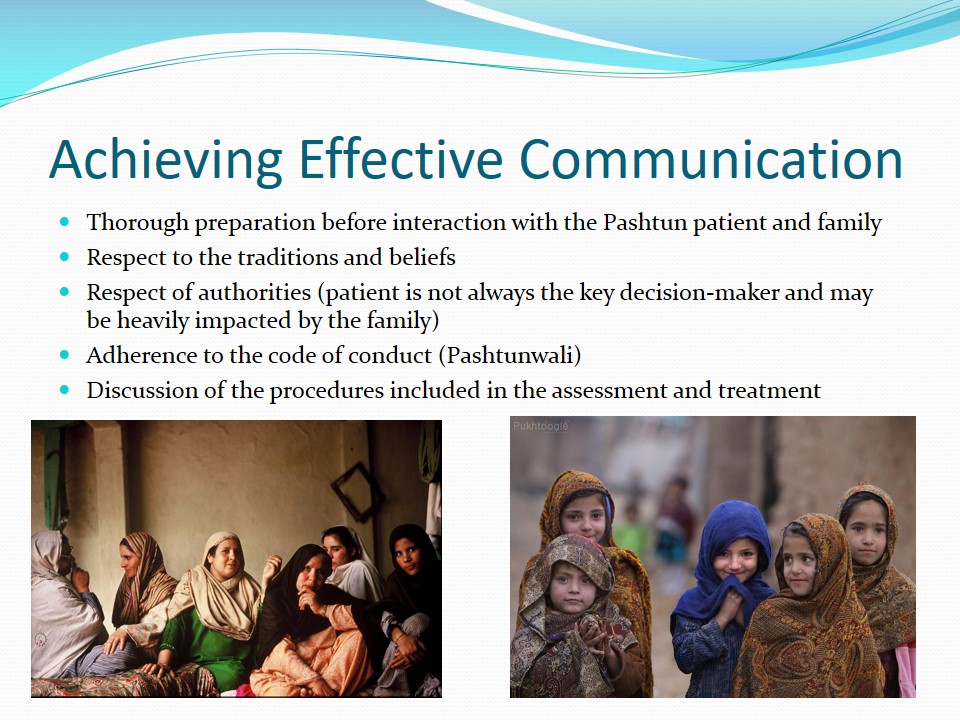
References
Lamar Soutter Library. (2016). Cultural Approaches to Pediatric Palliative Care in Central Massachusetts: Pakistani. Web.
Merrill, L., Paxson, D,. & Tobey, T. (2006). An Introduction to Afghanistan Culture. Web.
Pashtun Culture and History. (2011). Social Life of Pashtuns/Pukhtoons. Web.
Pashtun People. (2015). Web.
The Pashtun Times. (2016). The good doctor. Web.